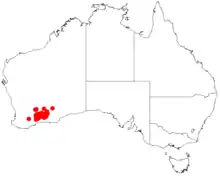| Acacia poliochroa | |
|---|---|
| Scientific classification | |
| Kingdom: | Plantae |
| Clade: | Tracheophytes |
| Clade: | Angiosperms |
| Clade: | Eudicots |
| Clade: | Rosids |
| Order: | Fabales |
| Family: | Fabaceae |
| Subfamily: | Caesalpinioideae |
| Clade: | Mimosoid clade |
| Genus: | Acacia |
| Species: | A. poliochroa |
| Binomial name | |
| Acacia poliochroa | |
 | |
| Occurrence data from AVH | |
Acacia poliochroa is a shrub belonging to the genus Acacia and the subgenus Phyllodineae that is endemic to south western Australia.
The prostrate to occasionally erect shrub typically grows to a height of 0.1 to 0.6 metres (0.3 to 2.0 ft) and has a dense domed habit[1] with puberulous branchlets. the green phyllodes are straight to shallowly incurved and rarely flat with a length of 1 to 2.5 cm (0.39 to 0.98 in) and a width of 1 to 2 mm (0.039 to 0.079 in).[2] It blooms from September to October and produces yellow flowers.[1] The rudimentary inflorescences rudimentary occur in pairs and have axes to a length of 0.5 mm (0.020 in). The spherical flower-heads have a diameter of 4 to 5 mm (0.16 to 0.20 in) and contain 16 to 21 light golden flowers. The linear, biconvex, blackish seed pods that form after flowering are strongly curved or form a single coil. The pods have a length of up to around 2 cm (0.79 in) and have a width of around 2 mm (0.079 in). The shiny dark brown seeds within have an oblong shape and a length of about 2 mm (0.079 in).[2]
It is native to an area in the eastern Wheatbelt and Goldfields-Esperance regions of Western Australia where it is found on flats, undulating plains and ironstone rises growing in clay to sandy loam soils.[1] The bulk of the population is situated between Lake King in the west through to Norseman in the east to Marvel Loch in the north as a part of open heath, mallee scrub and Eucalyptus woodland communities.[2]
See also
References
- 1 2 3 "Acacia poliochroa". FloraBase. Western Australian Government Department of Biodiversity, Conservation and Attractions.
- 1 2 3 "Acacia poliochroa". World Wide Wattle. Western Australian Herbarium. Retrieved 31 May 2019.